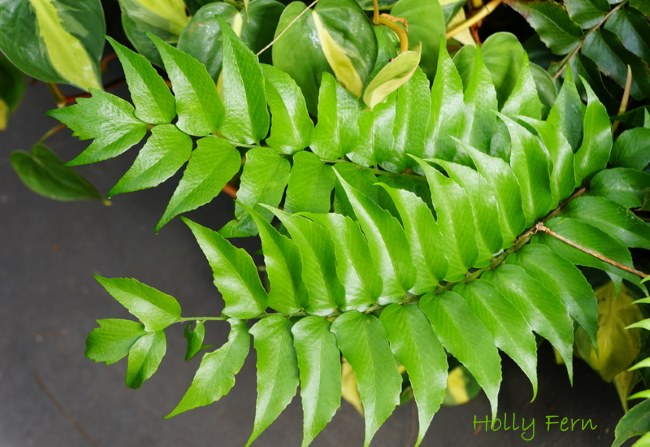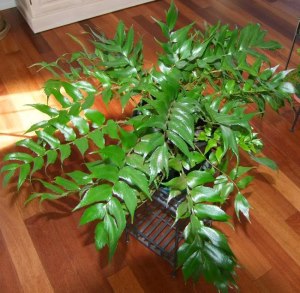Japanese Holly Fern
Botanical Name: Cyrtomium falcatum
Holly Fern is eye-catching on its own. But long fronds with thick, shiny green leaflets make this a handsome addition to any indoor plant grouping.
Combine this easy-care fern among variegated foliage plants, such as snow bush, colorful coleus or one of the prayer plants.
Get to know this evergreen perennial and discover how to care for it indoors. With this guide, you'll find out what kind of sunlight it wants year-round, how to water, and when to repot.
 Easy-to-grow Japanese Holly Fern makes a handsome houseplant. Photo © Khairil Junos
Easy-to-grow Japanese Holly Fern makes a handsome houseplant. Photo © Khairil JunosGet to Know Japanese Holly Fern
Broad, asymmetrical leaflets are about 3-4 inches (8-10 cm) long with sawtooth edges. Although it resembles the holly plant, the two aren't related.
Less fussy about humidity than most common indoor ferns, it flourishes in the home with little care. It is better behaved, too. Unlike many ferns, Cyrtomium falcatum does not shed.
How big does Holly Fern get? At maturity, the fronds will grow to 2 ft (60 cm) long, but tend to sprawl out rather than up. You'll want to give your houseplant some room to spread out.
Repot in spring because Holly Fern begins its most vigorous time of growth in summer. When repotting, make sure the crown of the plant is slightly above the soil line to prevent rot. Use a pot with drainage holes so that the soil won't get soggy. Now that you have your fern out of its container, this is a good time to divide it, if you want.
Something bugging your plant? Watch for scale insects, that look like small, brown discs on leaflets. (Sometimes the brown spores on the undersides of leaflets are mistaken for scale. You'll recognize the spores because they appear abundantly under each pinnae.) To remove scale insects, scrape them off with your fingernails. Don't use insecticides on ferns because they are easily damaged by chemicals.
Keep it clean. Those green leaflets are naturally glossy. Keep them clean by wiping them off with a damp cloth. Or take it to the sink for a lukewarm shower.
Yellow leaves? You overwatered. Holly Ferns grow from rhizomes that store water, making them more drought-tolerant than most ferns. Water thoroughly, then allow the top of the soil to dry out before watering again. You can prune off any yellow, brown or dry, crunchy fronds at the soil level.
How long do Holly Ferns live? This perennial evergreen fern will live for several years, with good care (it's easy). You can keep it going by dividing the plant about every 5 years.
Buying Tips for Holly Fern
You'll find Holly Fern for sale by its botanical name. Look for Cyrtomium falcatum to be sure you're getting this plant. It's well-worth seeking. This is one of the easiest ferns to grow indoors and makes a lush accent for your home.
Cyrtomium falcatum 'Rochfordianum' is a popular cultivar for growing indoors, sporting stubby, wavy leaflets. One variety, Maritimum is a dwarf form with 1-ft (30 cm) fronds.
 Photo credit: Helen Poirier
Photo credit: Helen PoirierGrowing Tips for Holly Fern
Origin: Japan and China
Light: Indirect light from a North- or East-facing window is ideal.
Water: Aim to keep the potting medium lightly moist at all times, but not soggy which can lead to root rot. Holly Fern grows from rhizomes and is more tolerant of dry soil than wet. Water thoroughly, then allow the top 1-inch (2.5 cm) of soil to dry before watering again. Use a pot with a drainage hole and empty the drainage tray after watering.
Humidity: Holly Fern prefers around 50% relative humidity. Humidity can drop drastically in the winter; it's a good idea to use a cool-mist room humidifier near your plant or stand the pot on a tray of wet pebbles.
Temperature: Average to warm (65-80°F/18-27°C) in the spring and summer months. Cooler in fall and winter (60-70°F/16-21°C). Cyrtomium falcatum is cold-tolerant and can withstand temperatures down to 30°F/-1°C. Don't worry about keeping this hardy fern near your windows or drafty entryways in winter -- it can take the cold.
Soil: Good-quality, all-purpose houseplant potting mix
Fertilizer: Feed monthly spring through fall with a balanced liquid fertilizer (such as 10-10-10) at half the recommended amount. Don't fertilize in the winter months when growth is slower.
Propagation: Divide Holly Fern in spring when it gets too big for its pot (probably every 5 years or so). To divide, cut rhizomes so that each piece has a growing tip and at least 3 fronds.


